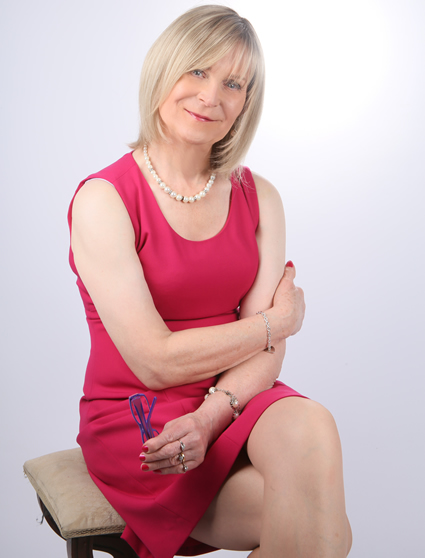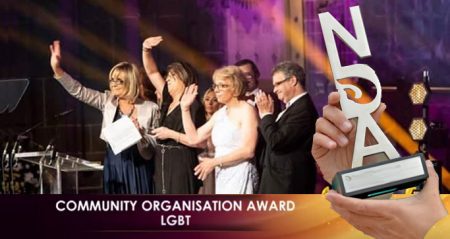
Steph Richards Image – taken in 2020. Copyright.
Steph Richards Trans Woman – My Story
I’m Steph Richards….we are all different …we all have a story.
I am publishing mine online so you, the reader, can get an idea of what it is like to have been born trans, “in the wrong body.”
I was born in 1952 when food rationing was still in existence. I lived with my parents and my older sister in an old, cold, four-roomed cottage deep in the English countryside. We did not have a car, bathroom, or even an inside toilet, so bath time was on a Friday night by the living room fire in a long tin bath.
Going to the loo meant a trip down the garden to a galvanised iron shed. Inside was a toilet seat secured to a wooden frame with a metal bucket underneath, which my father would regularly empty into holes dug into the surrounding farmland- and, of course, there was the stench. My father was a land worker, my mother a part-time cleaner for the local gentry (posh people), and without question, we were poor.
One of my first memories, probably at the age of four or five, was asking my mother for a dancing skirt, and she kindly obliged with one of my sister’s old skirts. It was a typical fifties cotton flared skirt, primrose yellow with blue and white flowers. Being seven years younger than my sister, it was way too big, so my mum would secure it around my waist with a safety pin. It was too long, but this added to the twirling sensation and fun I had dancing to fifties songs on the wireless (radio).
By the age of seven, my dad had built an extension to our home. We now had a bathroom, and I no longer had to share a bedroom with my parents.
My sister got promoted to the newly built bedroom, and finally, I got my own bedroom. This was very convenient because my sister’s first bedroom had very loose and broken floorboards, meaning I had a hiding place for all the clothes I had started stealing from her. At night, I would remove her clothes from under the floorboards, try them on, and fantasise that I was going to grow into a beautiful young woman.
I remember always staring at my sister’s blue Girl Guides uniform. I was desperate to wear it, but I knew I could not get away with wearing or stealing it.
At the age of ten, I remember being carried from the netball court by my school’s headmistress after being accidentally kneed in the stomach while jumping for the ball. I wanted to play in the netball team but could not because I was a ‘boy’.
Looking back, I was fortunate that my parents understood my gender issues from day one. Most parents in those days would have certainly tried to beat it out of their kids or seek medical help, eventually possibly resulting in electric shock treatment, which was commonplace in my younger days.
I was left alone at our home for the first time when I was about twelve, possibly thirteen – I don’t recall where my parents and sister went, but I do recall where I went; I walked through the village, wearing my sister’s clothes.
Many of my friends were girls at secondary school, and my friend Ann suggested I became a hairstylist once leaving school, an idea that worked for me. With my parent’s agreement, I applied to the local Technical College, and my mum and dad came with me for the initial interview. A pretty, tall girl in the waiting room accompanied by her mother. She, too, was waiting for an interview as a student hairdresser. I smiled, and she blushed profusely. We were engaged within two years and married two years later, I was twenty, and Linda was just nineteen.
After my hairdresser training, I worked for several big companies before ending my career in the beauty industry, working for a global brand. Of course, my hairdressing and makeup skills were beneficial to me.
Linda (Lin), my wife, knew from early on that I was trans; we had loads of fun, often going out shopping as sisters as I could typically “pass” reasonably easily. We built a successful retail business together, conveniently providing flats above the shops we rented, meaning I could dress femme whenever I wanted. Lin later extended the flats to become safe havens where men from across the area would come and secretly cross-dress away from their families.
Our marriage lasted 27 years before we parted, with Lin very suddenly deciding that she was fed up with one trans guy (I use the word ‘guy’ loosely), leaving myself and, surprisingly, our three kids for a new cross-dressing partner. Immediately after Lin and I split up, my trans strengths came to the fore! I became a mum and dad looking after my sons and daughter (aged just seven) pretty well, given the circumstances.
Sadly, a few years after we split up, Lin developed a highly aggressive cancer, and I, together with my kids, were at her bedside the day she died. A ruby and diamond ring that Lin gave me for my fortieth birthday remains, to this day, my favourite piece of jewellery and is worn every day.
Around one year later, I met my new wife “J”, and we fell instantly in love. We were engaged within a few weeks, and she (with her two daughters) moved in with us, making us a family of seven – we married a year later. J worked as an ‘Information Scientist’ for a blue chip multinational, and it was thanks to her that I learnt a whole new range of skills that led me to work with three national charities in later years.
Shortly afterwards, a new career took off.
J and I did everything together, from going for long walks (we covered about twenty miles a week) to sharing dresses. We loved going to the theatre and eating lovely meals at great restaurants, our favourite being the Coach at Marlow. We crowned ourselves “shopping world champions” sniffing out bargains (mainly dresses, shoes and tops) at one hundred yards.
I often feel sorry for a woman on a shopping spree with a cisgender man. Invariably, they sit outside the changing rooms, resembling a row of newly convicted prisoners about to suffer a root canal filling.
In 2010, J and I agreed I should go onto hormones. Because of a very concerning prostate issue, I was already on testosterone blockers, and I wanted peace with my true gender. I was by then 58 and became very much aware that life was slipping me by and that while almost everyone knew me as male, in reality, my wife and I knew my female side dominated me. I was not quite in the depths of despair (albeit I had started to have suicidal thoughts), but she knew I had been very patient in sorting out my gender dysphoria issues and had always looked after our family first.
Coming out to my excellent female GP (EW, thank you) was not easy, but she instantly confirmed she would prescribe me oestrogen subject “to passing the necessary psychiatric tests”.
From that point, I began to learn why so many trans people commit suicide (estimated 7-10 times higher than cisgender people) and understand why NHS help is almost non-existent.
Estimates suggest that in the UK, trans suicides could be in the hundreds each year, many of them very young. It is such a waste of life.
While I was exceedingly lucky to be able to handle my dysphoria for most of my life, most trans people simply cannot. In my case, I was able to tell myself I was ‘special’ and that being able to be a man or a woman was a gift.
Eventually, even this mindset is broken.
Being trans becomes all-consuming – an ever-pressing, natural obsession with becoming your true self eventually explodes to the surface. I can only beg parents that if their young (school-aged) son or daughter declares they have gender issues, take it seriously and be kind. If a boy says he is trans, it is likely true, but occasionally, girls change their minds a few years later, so extra care is required. In my experience, the crunch ages are often around seven and just before or after puberty.
Using the NHS route, trans people with Gender Dysphoria are referred to a Gender Identity Clinic. There are very few in the country, and the wait even for the initial appointment often runs into some years. I gave up waiting after one year and paid to go private. Luckily, I had the money, but most trans people do not, and if I add up the cost of my transition over the last ten years, it is close to £35k.
I, with my wife, went to see the psychiatrist, and within a couple of weeks, I was on a low dose of HRT oestrogen patches. Slowly but surely, the strength of the oestrogen dose got higher and higher, leading to me, after about two years, being in the female hormone range with my new impressive feminine figure!
When I came out to my GP, I also started having lots of laser treatments to remove body hair and weekly (very expensive) electrolysis treatments to remove facial & sensitive area hair. At times, in particular, around the sensitive areas, this was incredibly painful, and most people could not bear the pain for more than a few minutes at a time. There are two general types of surgery trans women often endure “bottom” and “top”. In my case, I was aiming for the bottom. I am happy with my boobs and, in any case, would never consider having implants because of the associated risks.
After nearly five years of painful electrolysis (totalling around 350 hours) plus 46 very successful female voice conversion therapy sessions, I was ready for the final stage of my transition: lower surgery and on the 2nd of July 2019, after nine years of waiting, I got my wish.
When I woke up in recovery after my surgery, I heard the most beautiful words from a nurse. She said, “You have fantastic skin and an amazing figure; now you can be the woman you want to be.” I could barely talk, but I asked her her name, and she replied, “Heather.”
A few weeks later, I sent her a thank-you card, which read: I do not remember your face or even the colour of your hair, but I will never ever forget those wonderful words you spoke to me on July 2, 2019. Thank you.
I can genuinely say my surgery day was the best day of my life. Initially, there was no pain …just relief.
As I settled into my new anatomy and name, which I had changed by deed poll, my personal questions started to erupt in my brain. Why was I trans? Why did I have to fight so hard to become the person I wanted to be?
After research, I am reasonably sure I found the correct answers. During my research about why I was trans, I found there is considerable MRI evidence to show that a map of a trans brain often matches the gender claimed by the trans person and if not a direct match, it does map between the cis male and female brain.
On the positive side, trans people are more accepted by society these days, especially by the beautiful younger generation, and naturally, more trans people feel relaxed about “coming out”. Thankfully, the old-fashioned idea that gender is binary is slowly but surely disappearing, and the fight that I suffered should (hopefully) become something of the past in the not-too-distant future. The negative side is hate, driven by a culture war against trans people.
A tremendous amount has happened since my surgery in 2019.
- I started an online blog called Steph’s Place, which, initially, was just me blogging about my transition. Over the years, it evolved into TransLucent, an organisation with a team of twenty+ volunteers. In 2022, we won LGBT Organisation of the Year and now advocate for the trans community with the government.
- From being shy and reserved, I have become confident (perhaps gobby) – I speak at events and have been platformed on numerous national media platforms, including BBC Womens Hour. I never imagined I would debate in a packed hall at an American university against a Harvard lecturer. I’m an old trans woman, for goodness sake!
- In 2023, I received an Inspirational Woman of Portsmouth Award for my feminism. In the same year, I became CEO of an Endometriosis Charity – the right-wing press (because of the culture war against trans women) went, well, loopy. Who would have imagined that Fox News and Piers Morgan (to name just two) would do massive “hit” pieces on me purely because I am trans? Perhaps what was (and is still) so distressing was all their lies, which I can do nothing about.
- However, there is a “bright side”, as kindly reported by Civil Society in May 2024 – I’m proud of what was achieved (endometriosis was trending on Twitter for a week). And yes, I still volunteer for the charity as the Parliamentary Engagement Officer.
- I am one of a handful of trans people (around 3%) who have a Gender Recognition Certificate – meaning I am legally female.
- Sadly, my wife J passed away in 2024 after a medical misdiagnosis – I miss her and think of her every single day.
So, to my final lines.
I would be a liar if I said I do not have regrets.
I regret missing out on childhood and not being a girl, not having a childbearing body… and not being a mum.
I feel I have been cheated of the life I should have had, but equally, I know around one-fifth of the trans people born in 1952 have died by their own hand – I am one of the lucky ones who has survived.
All the pain (both physical and mental), plus all the effort, has most certainly been worthwhile.
I am very grateful for all my support from my health professionals, family, friends, neighbours & work colleagues…to them, I can only say a huge “thank you”.
And I will remind you of what I wrote at the start of my story…….. ‘we are all different.
I am Steph Richards, a trans woman and a 72-year-old feminist human rights activist!
You can find me on Twitter @PompeySteph
UPDATE: March 2025. I have been nominated for the Role Model Award (National Diversity Awards 25) for my feminism. I would love to win this because its NOT an LGBT award and I want to prove trans people can and do play an positive role in society. We are just “people”. Please consider voting for me, it just takes 30 seconds – LINK.
Thank you.




 To provide the best experiences, we use technologies like cookies to store and/or access device information. Consenting to these technologies will allow us to process data such as browsing behaviour or unique IDs on this site. Not consenting or withdrawing consent, may adversely affect certain features and functions.
To provide the best experiences, we use technologies like cookies to store and/or access device information. Consenting to these technologies will allow us to process data such as browsing behaviour or unique IDs on this site. Not consenting or withdrawing consent, may adversely affect certain features and functions.